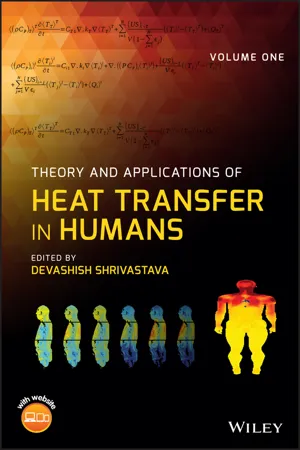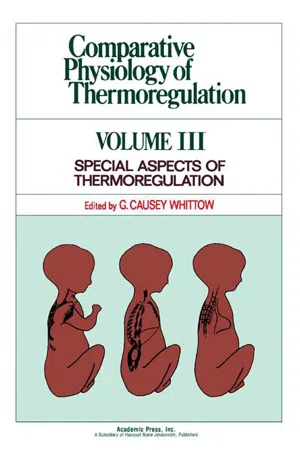Biological Sciences
Endotherm vs Ectotherm
Endotherms are organisms that can regulate their body temperature internally, typically maintaining a relatively constant temperature regardless of external conditions. Ectotherms, on the other hand, rely on external sources of heat to regulate their body temperature and their internal temperature fluctuates with the environment. This distinction is important in understanding how different organisms adapt to and interact with their environments.
Written by Perlego with AI-assistance
Related key terms
5 Key excerpts on "Endotherm vs Ectotherm"
- eBook - ePub
Ecology
From Individuals to Ecosystems
- Michael Begon, Colin R. Townsend(Authors)
- 2020(Publication Date)
- Wiley(Publisher)
But this distinction is not entirely clear‐cut. As we have noted, apart from birds and mammals, there are also other taxa that use heat generated in their own bodies to regulate body temperature, but only for limited periods; and there are some birds and mammals that relax or suspend their endothermic abilities at the most extreme temperatures. In particular, many endothermic animals escape from some of the costs of endothermy by hibernating during the coldest seasons: at these times they behave almost like ectotherms. endotherms: temperature regulation – but at a cost Birds and mammals usually maintain a constant body temperature between 35 and 42°C, and they therefore tend to lose heat in most environments; but this loss is moderated by insulation in the form of fur, feathers and fat, and by controlling blood flow near the skin surface. When it is necessary to increase the rate of heat loss, this too can be achieved by the control of surface blood flow and by a number of other mechanisms shared with ectotherms like panting and the simple choice of an appropriate habitat. Together, all these mechanisms and properties give endotherms a powerful (but not perfect) capability for regulating their body temperature, and the benefit they obtain from this is a constancy of near‐optimal performance. But the price they pay is a large expenditure of energy (Figure 2.12), and thus a correspondingly large requirement for food to provide that energy. Over a certain temperature range (the thermoneutral zone) an endotherm consumes energy at a basal rate. But at environmental temperatures further and further above or below that zone, the endotherm consumes more and more energy in maintaining a constant body temperature - Devashish Shrivastava(Author)
- 2018(Publication Date)
- Wiley(Publisher)
et al. (2008). Reproduced with permission of Elsevier.Some animals (e.g., reptiles) are thermal conformers in that they allow their body temperature to vary with ambient conditions; these are ectothermal species. Mammals, on the other hand, are regulators that evolved with effector mechanisms designed to achieve a relatively stable mean body temperature (Brown and Brengelmann, 1970; Jessen, 1996; Werner et al., 2008), with that level generally being associated with good health and optimal function. Endothermy, however, comes at a physiological cost, and the narrower the zone of thermal indifference (thermoneutrality), the more costly are the homeostatic processes recruited to sustain that state. Consequently, homeostasis does not imply absolute thermal constancy, for there are circumstances in which it can be advantageous, and sometimes even protective, to regulate body temperature above or below the normothermic state. For instance, when exercising in the heat, the typical body temperature of a regulating, resting person (normothermia) drifts upwards. This permissive, yet regulated, mild hyperthermia simultaneously reduces dry-heat gain and elevates the cutaneous water vapour pressure, thereby increasing evaporative cooling without increasing sweat flow. In some circumstances, the mean body temperature rises and stabilises at a higher steady state. In more stressful conditions, a thermal steady state may not eventuate, but its elevation rate is autonomically reduced. These are tolerable and regulated states, although they both have finite tolerance limits. In the cold, the opposite occurs, with mild hypothermia reducing heat loss, with an eventual physiological amputation at the hands and feet in more extreme states serving to protect vital structures (Taylor et al- eBook - ePub
- Michael Pawlyn(Author)
- 2019(Publication Date)
- RIBA Publishing(Publisher)
Stegosaurus ) show that they were richly vascular and may have been used for both absorbing and shedding heat, depending on whether the creature positioned itself side on to the sun or to face the wind. In other cases, the characteristics of the habitat to which an organism has adapted have resulted in one strategy being more pronounced than the other.Some animals, known as homeotherms, generate heat from within and keep their bodies at a steady temperature, while poikilotherms absorb heat from their environment and allow their body temperature to vary quite widely. The history of environmental engineering shows that humans have been growing increasingly demanding in terms of what we regard as a comfortable temperature band in our buildings. This can reach levels of absurdity when, in certain parts of the world, office buildings are heated to 24 °C in winter and cooled to 19 °C in summer. The energy implications of this are huge, so reversing this shift and encouraging clients to tolerate a wider thermal comfort envelope is a critical first stage in designing a low-energy building. This can normally be done with thermal-modelling exercises rather than trying to persuade clients to evolve into poikilotherms or thermophiles.141Keeping warm
The two main sources of heat for organisms are both based on solar energy: first, indirectly through metabolising food and, second, through direct solar gain.The continual generation of heat from metabolism results in many biological solutions to keeping warm being based on reducing heat loss. Insulation, a familiar strategy in buildings, could find new modes of action from nature here. For land mammals in temperate regions there are two main physiological ways in which this is achieved: a subcutaneous layer of insulating fat and a dense layer of fur. Those like the polar bear and the reindeer that live in colder regions have further adaptations, such as hollow hair fibres for added insulation. Polar bear fur inspired an initial biomimetic response, a wall system, which turned out to be based on faulty scientific understanding (the hair filaments were thought to conduct sunlight down to the animal’s dark skin). This comes closer to biomythologically-inspired design than biomimicry, but as long as we continue to adapt to new scientific knowledge then we are acting as scientists do themselves. New discoveries change existing knowledge and can lead to different avenues of discovery but do not, by definition, devalue existing viable solutions. Reindeer fur includes a very dense underlayer of fur that traps air against the skin to reduce convection loss, while longer guard hairs minimise wind chill by repelling water. Penguins have evolved feathers that allow them to respond to two very different conditions. While swimming, the bird’s feathers are held flat against the body for optimum streamlining; on land, the penguin lifts its feathers so that the mass of downy filaments at the base of each form millions of pockets of trapped air for effective insulation. The bird is able to maintain a temperature difference of 60 °C between its body and the exterior with just a 20 mm thick layer of feathers. There are also some examples of insulation found in the plant kingdom, such as the groundsel trees that grow on the slopes of Mount Kenya. They accumulate a thick layer of dead leaves from previous years that provide insulation to the trunk and prevent water within the vascular tissues from freezing. - eBook - ePub
The Neurobiology of Behavior
An Introduction
- Gordon J. Mogenson(Author)
- 2018(Publication Date)
- Routledge(Publisher)
3Thermoregulatory Behavior
Thermal homeostasis in the animal world is achieved by two principal systems: behavioral and autonomic regulation [Benzinger, 1964, p. 831].An important biological principle is that physiological and behavioral adaptations occur in response to variations of the animal’s environment. One of the important environmental variations is temperature, and mechanisms have evolved that enable warm-blooded mammals to maintain a relatively constant body temperature in the face of wide fluctuations of air temperature from one time of the year to another and from one part of the day to another. The moose or buffalo of the North American plains experiences extremely cold weather in the winter and rather high temperatures during certain days in the summer. The temperature during periods of the year may differ by 15°-20°C between midday and midnight. The lion and tiger living in tropical zones experience ambient temperatures of 40°C or higher, and when captured and placed in a zoo in northern Europe or Canada, they may be exposed to –10° to –20°C or lower during the winter. At the other extreme, the polar bear survives subarctic weather but can also adjust to temperatures of the temperate zone. The regulation of body temperature in animals living in environments with such wide fluctuations of air temperature is, as indicated by the quotation from Benzinger, the result of both behavioral and physiological thermoregulatory responses.These two kinds of responses of an animal to changes in the temperature of its environment have a complementary role in maintaining body-temperature homeostasis, and they frequently occur concurrently. For example, a rat exposed to the cold may build a nest or in the laboratory may press a lever to turn on a heat lamp; at the same time, there will be peripheral vasoconstriction to reduce heat loss and increased discharge of the sympathetic nervous system and increased output of thyroid hormones to increase metabolic heat production. It seems appropriate to begin, therefore, with a consideration of these two kinds of thermoregulatory responses before directing our attention later in the chapter exclusively to behavioral thermoregulatory responses. In the later sections, we deal first with the characteristics and determinants of thermoregulatory behaviors as a perspective for considering what is known about the neural substrates. - eBook - ePub
Comparative Physiology of Thermoregulation
Special Aspects of Thermoregulation
- G. Causey Whittow, G. Causey Whittow(Authors)
- 2013(Publication Date)
- Academic Press(Publisher)
Whittow, 1971 ). Increased salivation during exposure to heat is necessary in animals that pant, in order to provide the fluid for evaporation. It is, therefore, phylogenetically as old as the panting response itself.VI Behavior
The feature that distinguishes thermoregulatory behavior from physiological mechanisms of temperature regulation is the participation of conscious effort in the behavioral response (Hardy et al. , 1971). While this distinction is readily apparent in higher vertebrates, is it generally applicable to include invertebrates as well? Is this definition compatible with behavior elicited by heating or cooling the medulla or spinal cord (Lipton, 1971 ; Spector and Cormarèche, 1971 )? This is a question of semantics which will not be pursued further here. Thermoregulatory behavior usually involves movement of the entire animal, or part of the animal such as a limb, in response to a change of either environmental temperature or body temperature.For purposes of discussion, thermoregulatory behavior may be considered under three headings: feeding, activity, and specific thermoregulatory behavior.A FOOD INTAKE
Unfortunately, very little seem to be known about the food intake of invertebrates, or the so-called poikilotherms. under different environmental conditions. However, in endotherms, it is a simple matter to adduce evidence in support of an increased food intake in the cold and reduced food consumption during exposure to heat (see Hart, 1971 ; Whittow, 1971) . It is also easy to justify the changes in food intake in terms of differing energy requirements in cold and hot environments. There is also an interaction between specific thermoregulatory behavior and food intake. Thus, Baldwin and Ingram (1968)
Learn about this page
Index pages curate the most relevant extracts from our library of academic textbooks. They’ve been created using an in-house natural language model (NLM), each adding context and meaning to key research topics.




